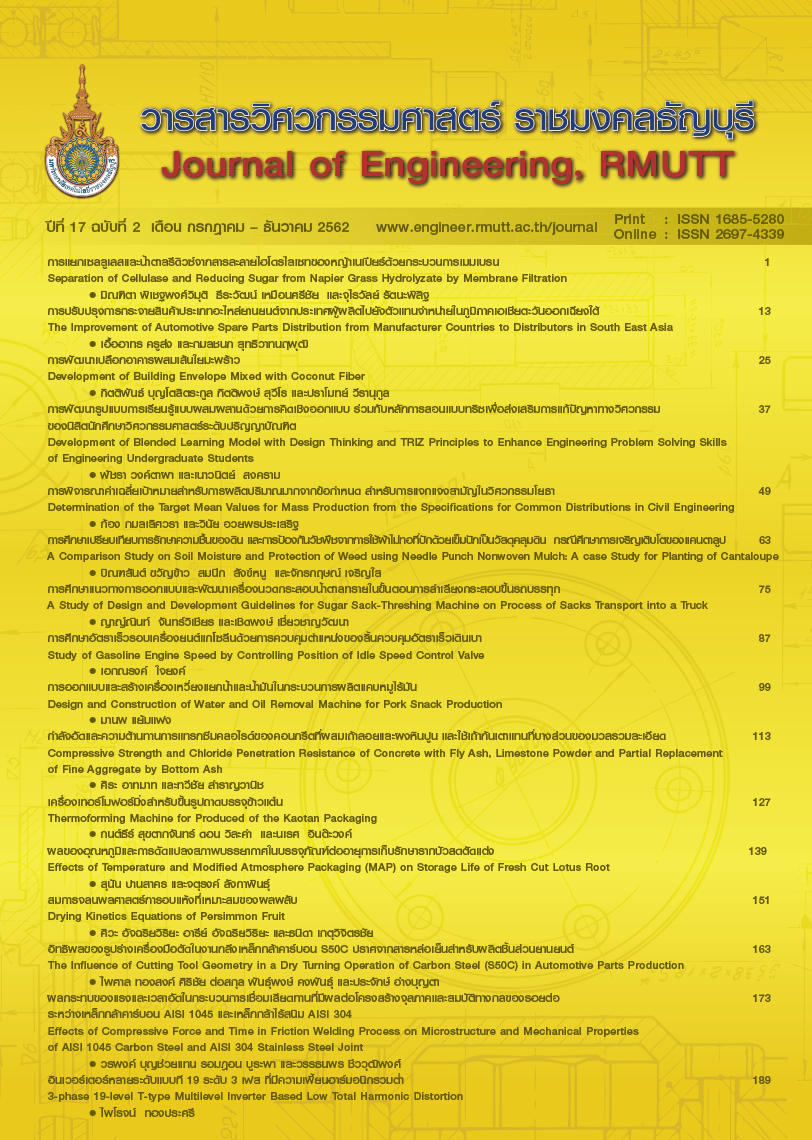Development of Building Envelope Mixed with Coconut Fiber
Main Article Content
Abstract
The objective of this research is developed the building envelope mixed with coconut fiber. The 6 ratios of Portland cement type 1 mixing of fine sand: coconut fiber: waterproofed liquid: tap water were designed which proportion to 1: 3: 0: 0.02: 0.5, 1: 3: 0.05: 0.02: 0.5, 1: 3: 0.1: 0.02: 0.5, 1: 3: 0.15: 0.02: 0.5, 1: 3: 0.2: 0.02: 0.5, and 1: 3: 0.25: 0.02: 0.5 by weight. The samples were tested to find engineering properties at 28 days of curing in ambient. According to the results, the suitable amount of coconut fiber can reduce the density and thermal conductivity, and increase the bending strength of building envelope mixed with coconut fiber. The 1: 3: 0.1: 0.02: 0.5 of ratio was the suitable ratio to use as the building envelope, and it had the properties as following: density 1,582 kg/m3, thermal conductivity coefficient 0.371 watt/m.Kelvin, water absorption 17.31 %, compressive strength 118 ksc, and bending strength 29 ksc. This developed building envelope can apply to cast and plaster as the walls in the building.
Article Details
The manuscript, information, content, picture and so forth which were published on Frontiers in engineering innovation research has been a copyright of this journal only. There is not allow anyone or any organize to duplicate all content or some document for unethical publication.
References
Asasutjarit C, Hirunlabh J, Khedari J, Charoenvai S, Zeghmati B, Shin UC. Development of coconut coir-based lightweight cement board. Construction and Building Materials. 2007; 21(2): 277–288.
Office of the Higher Education Commission (OHEC). Development of light-weight materials from coconut fiber, research and technology transfer project in coconut. Bangkok: Research Network: Lower Central, Office of the Higher Education Commission; 2004. (in Thai)
Weeranukul P, Suweero K. Development of cement boards from coconut shell ash for energy and environment conservation. KKU Engineering Journal. 2016; 43(S1): 173-175. (in Thai)
Thai Industrial Standards Institute (TISI). Thai industrial standard no.58-1990: hollow non-load-bearing concrete masonry units.Bangkok: Thai Industrial Standards Institute; 1990. (in Thai)
Thai Industrial Standards Institute (TISI). Thai industrial standard no.378-1988: concrete floor tile. Bangkok: Thai Industrial Standards Institute; 1988. (in Thai)
American Society for Testing and Materials (ASTM). Standard test method for steady-state heat flux measurements and thermal transmission properties by means of the guarded-hot-plate apparatus. Philadelphia: ASTM International; 2010.
Faherty KF, Williamson TG. Wood engineering and construction handbook. 2nd ed. New York: McGraw-Hill, Inc.; 1995.
Jindaprasert P, Jaturapitakkul C. Cement, pozzolan, and concrete. 7th ed. Bangkok: ACI Partners with Thailand Concrete Association; 2012. (in Thai)
Pakunworakij T, Puthipiroj P, Oonjittichai W, Tisavipat P. Thermal resistance efficiency of building insulation material from agricultural waste. Journal of Architectural/Planning Research and Studies. 2006; 3(4): 119-126. (in Thai)
Bledzki AK, Gassan J. Composites reinforced with cellulose based fibers. Progress in Polymer Science. 1999; 24: 221-274.
Padkhoa N. The production and study property of insulation wall light board from bagasse fiber for using in architecture work. Journal of Engineering, RMUTT. 2015; 13(2): 11-20. (in Thai)
Thai Industrial Standards Institute (TISI). Thai industrial standard no.1776-1999: dry mortar for plastering. Bangkok: Thai Industrial Standards Institute; 1999. (in Thai)


